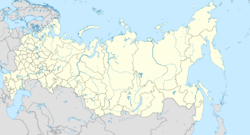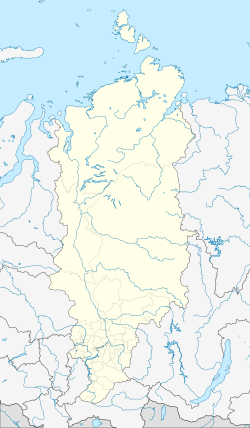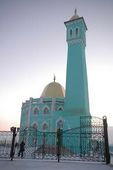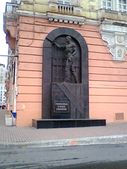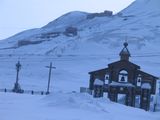نوريلسك
{{ safesubst:#invoke:Unsubst||date=__DATE__|$B=
Norilsk
Норильск | |
|---|---|
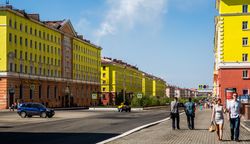 Norilsk Center, Leninsky Prospekt | |
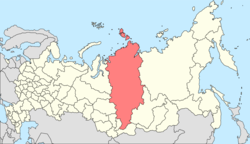 كراي كراسنويارسك | |
أظهر Location of Norilsk | |
| الإحداثيات: 69°20′N 88°13′E / 69.333°N 88.217°E | |
| البلد | روسيا |
| الكيان الاتحادي | Krasnoyarsk Krai[1] |
| Founded | 1935[2] |
| مدينة status since | 1953[2] |
| المنسوب | 90 m (300 ft) |
| التعداد | |
| • الإجمالي | 175٬365 |
| • Estimate (2018) | 179٬554 (+2٫4%) |
| • الترتيب | 102nd in 2010 |
| • Subordinated to | krai city of Norilsk[1] |
| • Capital of | krai city of Norilsk[1] |
| • Urban okrug | Norilsk Urban Okrug[4] |
| • Capital of | Norilsk Urban Okrug[4] |
| منطقة التوقيت | UTC+ ([5]) |
| Postal code(s)[6] | 663300-663341 |
| Dialing code(s) | +7 3919[7] |
| OKTMO ID | 04729000001 |
| الموقع الإلكتروني | www |
نوريلسك (روسية: Норильск; النطق الروسي: [nɐˈrʲilʲsk]) مدينة روسية تقع في محافظة كراسنويارسك، روسيا، وتقع فوق الدائرة القطبية، شرق نهر ينيسـِيْ وجنوب شبه جزيرة تايمير الغربية. It has a permanent population of 175,000. With temporary inhabitants included, its population reaches 220,000.
It is the world's northernmost city with more than 100,000 inhabitants. وقد اكتسبت المدينة مكانة رفيعة عام 1953. وهي ثاني أكبر مدينة (بعد مورمانسك) داخل الدائرة القطبية. نوريلسك وياقوتسك هما المدينتان الكبيرتان الوحيدتان في منطقة continuous permafrost.
رواسب النيكل في نوريلسك-تالناخ هي أكبر رواسب نيكل-نحاس-پلاديوم في العالم. The smelting of the nickel ore is directly responsible for severe pollution, which generally comes in the form of acid rain and smog. By some estimates, one percent of global sulfur dioxide (SO 2) emissions come from Norilsk's nickel mines.[8] شركة نورنيكل تقوم أعمالها الرئيسية في المنطقة حيث هي أكبر رب عمل في المدينة.
الاسم
Norilsk owes its name to its geographical location: the Norilsk river flows near the city (Norilka, Pyasina river basin), the city itself is located near the Norilsk mountains. Travelers Khariton Laptev, Alexander Fyodorovich Middendorf, and Fedor Bogdanovich Schmidt mention the river Norilsk and Norilsk mountains in their reports. The Norilskaya River got its former name, Norilka, probably at the time when Taymyr was inhabited by Russian fishing people in the 16th–17th centuries during the existence of the city Mangazeya. Probably, the name of the river comes from the word "norilo", a long thin pole, which stretched the string of set nets under the ice from hole to hole. According to another version, the name of the river (Norilka) and, accordingly, the city comes from the Evenk word "narus" or Yukagir language "nioril", which means "swamps". It is also possible from the name of the Evenk tribe "Nyurilians".[9]
التاريخ
 خريطة نوريلسك (معنونة NORIL'SK) والمنطقة المحيطة (مصلحة خرائط الجيش، 1964) |
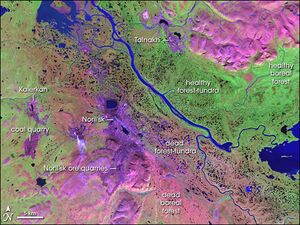
Norilsk was founded at the end of the 1920s, but the official date of founding is traditionally 1935, when Norilsk was expanded as a settlement for the Norilsk mining-metallurgic complex and became the center of the Norillag system of Gulag labor camps. It was granted urban-type settlement status in 1939 and town status in 1953.[10]
Norilsk is located between the West Siberian Plain and Central Siberian Plateau at the foot of the 1,700-meter-high (5,600 ft) Putoran Mountains, on some of the largest nickel deposits on Earth. Consequently, mining and smelting ore are the major industries. Norilsk is the center of a region where nickel, copper, cobalt, platinum, palladium and coal are mined. Mineral deposits in the Siberian Craton had been known for two centuries before Norilsk was founded, but mining began only in 1939, when the buried portions of the Norilsk-Talnakh intrusions were found beneath mountainous terrain.
Talnakh is the major mine/enrichment site now from where an enriched ore emulsion is pumped to Norilsk metallurgy plants.
To support the new city, the Norilsk railway to the port of Dudinka on the Yenisei River was established, first as a narrow-gauge line (winter 1935–36), later as 1٬520 mm (4 ft 11 27⁄32 in) Russian standard gauge line (completed in the early 1950s).[11] From Dudinka, enriched nickel and copper are transported to Murmansk by sea and, then, to the Monchegorsk enrichment and smelting plant on the Kola Peninsula, while more precious content goes up the river to Krasnoyarsk. This transportation takes place only during the summer. The port of Dudinka is closed and dismantled during spring's ice barrier floods of up to 20 meters (66 ft) in late May (a typical spring occurrence on all Siberian rivers).[12]
In the early 1950s, the Salekhard–Igarka Railway was under construction from the European coal city Vorkuta via the Salekhard/Ob River, and Norilsk got a spacious railway station built in the expectation of train service to Moscow,[11] but construction stopped after Joseph Stalin died.
According to the archives of Norillag, 16,806 prisoners died in Norilsk under the conditions of forced labor, starvation and intense cold during the existence of the camp (1935–1956).[13] Fatalities were especially high during World War II from 1942 to 1944 when food supplies were particularly scarce. Prisoners organized the non-violent Norilsk uprising in 1953. An unknown, yet significant number of prisoners continued to serve and die in the mines until around 1979.
A number of Finnish companies assisted in the construction and automation of Norilsk's No. 2 copper and nickel smelters (in the so-called Nadezhda complex), which led to bringing substantial numbers of Finnish metallurgical and automation experts and their families to Norilsk starting in 1978, creating a Finnish expat community of some hundreds of people for a couple of years.[14] Norilsk before and after that has remained a closed city.
Norilsk-Talnakh continues to be a dangerous mine to work in. According to the mining company, there were 2.4 accidents per thousand workers in 2005. In 2017, Norilsk Nickel claimed that it had reduced its overall lost time injury frequency rate by almost 60% since 2013.[15]
In June 2020, 20,000 tons of diesel fuel spilled from the tank of an NTEK power plant.
الجغرافيا والمناخ
| أخفClimate data for Norilsk | |||||||||||||
|---|---|---|---|---|---|---|---|---|---|---|---|---|---|
| Month | Jan | Feb | Mar | Apr | May | Jun | Jul | Aug | Sep | Oct | Nov | Dec | Year |
| Record high °C (°F) | −3.0 (26.6) |
−2.0 (28.4) |
7.4 (45.3) |
10.5 (50.9) |
22.8 (73.0) |
30.4 (86.7) |
32.0 (89.6) |
28.7 (83.7) |
18.6 (65.5) |
9.6 (49.3) |
3.1 (37.6) |
−1.0 (30.2) |
32.0 (89.6) |
| Mean daily maximum °C (°F) | −23.6 (−10.5) |
−23.9 (−11.0) |
−18.4 (−1.1) |
−10.0 (14.0) |
−1.7 (28.9) |
10.4 (50.7) |
18.2 (64.8) |
15.0 (59.0) |
6.9 (44.4) |
−6.7 (19.9) |
−16.9 (1.6) |
−21.6 (−6.9) |
−6.2 (20.8) |
| Daily mean °C (°F) | −26.9 (−16.4) |
−27.2 (−17.0) |
−21.9 (−7.4) |
−13.9 (7.0) |
−4.8 (23.4) |
7.0 (44.6) |
14.3 (57.7) |
11.4 (52.5) |
4.0 (39.2) |
−9.5 (14.9) |
−20.2 (−4.4) |
−25.1 (−13.2) |
−9.6 (14.7) |
| Mean daily minimum °C (°F) | −30.7 (−23.3) |
−31.0 (−23.8) |
−26.4 (−15.5) |
−18.5 (−1.3) |
−8.4 (16.9) |
3.2 (37.8) |
10.0 (50.0) |
7.6 (45.7) |
1.2 (34.2) |
−12.5 (9.5) |
−23.9 (−11.0) |
−28.9 (−20.0) |
−13.4 (7.9) |
| Record low °C (°F) | −53.1 (−63.6) |
−52.0 (−61.6) |
−46.1 (−51.0) |
−38.7 (−37.7) |
−26.8 (−16.2) |
−9.8 (14.4) |
0.4 (32.7) |
−1.0 (30.2) |
−14.0 (6.8) |
−36.0 (−32.8) |
−43.1 (−45.6) |
−63.0 (−81.4) |
−63.0 (−81.4) |
| Average precipitation mm (inches) | 17.6 (0.69) |
16.1 (0.63) |
28.4 (1.12) |
21.1 (0.83) |
24.0 (0.94) |
34.4 (1.35) |
32.4 (1.28) |
52.2 (2.06) |
26.0 (1.02) |
35.9 (1.41) |
30.8 (1.21) |
22.1 (0.87) |
341 (13.41) |
| Source 1: Weatherbase, except for the July record high | |||||||||||||
| Source 2: July record high: Official website of Norilsk. В Норильске самый жаркий июль за всю историю метеонаблюдений (بالروسية); The Siberian Times. Norilsk breaks records for Arctic heat in a new sign of changing weather patterns | |||||||||||||
التلوث
Nickel ore is smelted at the company's processing site at Norilsk. This smelting is directly responsible for severe pollution, that generally comes in the form of acid rain and smog. By some estimates, one percent of global sulfur dioxide emission comes from Norilsk's nickel mines.[16] Heavy metal pollution near Norilsk is so severe that it has now become economically feasible to mine surface soil, as the soil has acquired such high concentrations of platinum and palladium.[17]
Norilsk-Talnakh nickel deposits
The nickel deposits of Norilsk-Talnakh are the largest-known nickel-copper-palladium deposits in the world. The deposit was formed 250 million years ago during the eruption of the Siberian Traps igneous province (STIP). The STIP erupted over one million cubic kilometers of lava, a large portion of it through a series of flat-lying lava conduits below Norilsk and the Talnakh Mountains.
The ore was formed when the erupting magma became saturated in sulfur, forming globules of pentlandite, chalcopyrite, and other sulfides. These sulfides were then "washed" by the continuing torrent of erupting magma, and upgraded their tenor with nickel, copper, platinum and palladium.[بحاجة لمصدر]
The current resource known for these mineralized intrusion exceeds 1.8 billion tons.[18] MMC Norilsk Nickel, headquartered in Moscow, is the principal mining operator in Norilsk-Talnakh. The ore is mined underground via several shafts, and a decline. The ore deposits are currently being extracted at more than 1,200 m (3,900 ft) below ground and drilled from the surface. Nickel production for 2008 amounted to 299.7 thousand metric tonnes. Copper production for 2008 amounted to 419 thousand metric tonnes.[بحاجة لمصدر]
The deposits are being explored by a Russian government-controlled company. The company is known to be using electromagnetic field geophysics, with loops on surface which are over 1,000 m (3,300 ft) on a side. Theyقالب:Who? are conclusively able to image the conductive nickel ore at depths in excess of 1,800 m (5,900 ft).[بحاجة لمصدر]
الثقافة
Norilsk Golgotha, a memorial to Gulag prisoners who labored at Norilsk
Twin towns and sister cities
Norilsk is twinned with:
 Minusinsk, Russia
Minusinsk, Russia
شاهد أيضا
المراجع
الهامش
- ^ أ ب ت ث خطأ استشهاد: وسم
<ref>غير صحيح؛ لا نص تم توفيره للمراجع المسماةRef66 - ^ أ ب Michail V. Kozlov; Elena Zvereva; Vitali Zverev (28 July 2009). Impacts of Point Polluters on Terrestrial Biota: Comparative analysis of 18 contaminated areas. Springer Science & Business Media. p. 63. ISBN 978-90-481-2467-1.
- ^ Russian Federal State Statistics Service (2011). "Всероссийская перепись населения 2010 года. Том 1". Всероссийская перепись населения 2010 года (2010 All-Russia Population Census) (in Russian). Federal State Statistics Service. Retrieved June 29, 2012.
{{cite web}}: Invalid|ref=harv(help); Unknown parameter|trans_title=ignored (|trans-title=suggested) (help)CS1 maint: unrecognized language (link) - ^ أ ب خطأ استشهاد: وسم
<ref>غير صحيح؛ لا نص تم توفيره للمراجع المسماةRef763 - ^ "Об исчислении времени". Официальный интернет-портал правовой информации (in Russian). 3 June 2011. Retrieved 19 January 2019.
{{cite web}}: CS1 maint: unrecognized language (link) - ^ Почта России. Информационно-вычислительный центр ОАСУ РПО. (Russian Post). Поиск объектов почтовой связи (Postal Objects Search) (in روسية)
- ^ "телефонных кодов" (in Russian). Retrieved 7 February 2016.
{{cite web}}: CS1 maint: unrecognized language (link) - ^ "Norilsk, Siberia". NASA. November 30, 2015. Retrieved 8 February 2016.
- ^ "Norilsk resident, # 8 (67) 03.03.05" (in الروسية). Archived from the original on 2005-04-23. Retrieved 2009-07-20.
- ^ "Life behind closed doors in the Arctic is.....fun!". siberiantimes.com.
- ^ أ ب По рельсам истории Archived سبتمبر 29, 2007 at the Wayback Machine(in روسية) ("Rolling on the rails of history"), Zapolyarnaya Pravda, No. 109 (July 28, 2007)
- ^ "Northern Sea Route Information Office". Archived from the original on February 15, 2016. Retrieved 8 February 2016.
- ^ Люди Норильлага (in الروسية).
- ^ Minerals Yearbook 1978–79 Volume III Area Reports: International, United States Department of Mines, page 985, 1979.
- ^ "Norilsk – Mining Hell" (PDF). Retrieved 8 February 2016.
- ^ "Norilsk, Siberia". NASA. Retrieved 8 February 2016.
- ^ Kramer, Andrew E. (July 12, 2007). "For One Business, Polluted Clouds Have Silvery Linings". The New York Times. Retrieved July 12, 2007.
- ^ "Mineral Reserves and Resources Statement". MMC Norilsk Nickel. November 3, 2008.
المصادر
- قالب:RussiaAdmMunRef/kya/admlist
- قالب:RussiaAdmMunRef/kya/munlist/norilsk
- "Norilskaya golgofa"(بالروسية) "Memorial", regional Branch "Siberia", publisher: "Klaretianum", Krasnoyarsk, 2002
وصلات خارجية
- Official website of Norilsk (بالروسية)
- MMC Norilsk Nickel
- Would You Live in This Toxic, Closed-Off City?, video profile of city by The Atlantic (2017)
- Pages using gadget WikiMiniAtlas
- CS1 errors: unsupported parameter
- Articles with روسية-language sources (ru)
- CS1 الروسية-language sources (ru)
- CS1 uses الروسية-language script (ru)
- Short description is different from Wikidata
- Infobox mapframe without OSM relation ID on Wikidata
- Coordinates on Wikidata
- Articles containing روسية-language text
- Articles that mention track gauge 1520 mm
- Articles with unsourced statements from July 2016
- مدن مغلقة
- أماكن مأهولة في كراي كراسنويارسك
- أماكن مأهولة تأسست في عقد 1920
- مدن وبلدات أنشئت في الاتحاد السوڤيتي
- أماكن مأهولة في روسيا القطبية
- Monotowns in Russia
- تأسيسات 1935 في الاتحاد السوڤيتي
- مدن روسيا
- صفحات مع الخرائط


